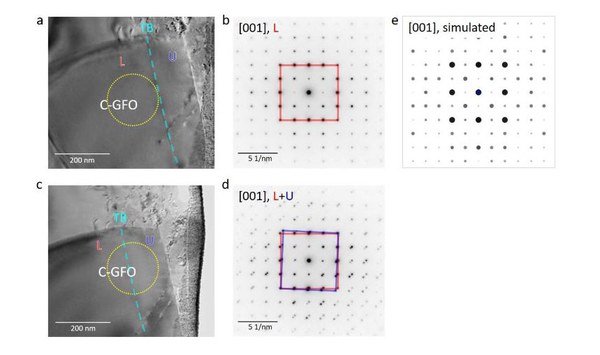Spontaneous Polarizability of the Grain Boundary Mapped at the Atomic Level
Grain boundaries of gadolinium iron oxide accurately mapped using extremely high resolution

04 July 2023 – As part of the DFG project "The role of interfaces in multiphase cerium dioxide-based membranes for use in membrane reactors" coordinated by Dr Kerstin Neuhaus from Helmholtz Institute Münster (HI MS; IEK-12) of Forschungszentrum Jülich, the grain boundaries of a gadolinium iron oxide (GdFeO3) were precisely mapped using extremely high resolution. Together with the project partners from Ernst Ruska-Centre for Microscopy and Spectroscopy with Electrons (ER-C) and the Institute for Energy and Climate Research 1 (IEK-1), also part of Forschungszentrum Jülich, as well as RWTH Aachen University and Physikalisch-Technische Bundesanstalt (National Metrology Institute), the team was able to show that under certain circumstances a strong spontaneous polarisability of the grain boundary occurs in the material.
Influence of Iron Oxide on Oxygen Ion Conductivity
Ceria is a ceramic material that conducts oxygen ions and is used, for example, as a catalyst for partial oxidation reactions. In their research work, Neuhaus' project team is focusing in particular on the effect of iron oxide on the oxygen ion and electron conductivity of the material, since iron occurs, for example, in sintering aids and can diffuse into cerium dioxide through contact with a second, iron-rich phase or also from steel components. In a publication from 2019, the researchers already addressed the effects of iron oxide addition on conductivity, oxygen diffusion and the formation of second phases.
Spontaneous Polarisability of the Grain Boundary
The cerium-doped gadolinium-iron oxide GdFeO3 formed as a second phase from gadolinium-doped cerium dioxide and iron oxide is a material with a cubic perovskite structure. It exhibits interesting properties at the interfaces when two GdFeO3 grains collide at a certain angle, the 100 twin grain boundary. Using transmission electron microscopy-based investigations at the ER-C, these grain boundaries could now be mapped with atomic resolution. This has revealed a distortion of the gadolinium sublattice and an increased occurrence of oxygen vacancies. These distortions can lead to a strong spontaneous polarisation of the grain boundary.
The results obtained are crucial for the targeted development of interfaces with superior properties, such as localised functionality (superconductivity or ferroelectricity).
Study Available in Nano Letters
The detailed results of their study were published as an open access article in the journal Nano Letters by the researchers Dr Ke Ran, Dr Juri Barthel, Dr Lei Jin and Prof. Dr Joachim Mayer, RWTH Aachen University and Ernst Ruska-Centre for Microscopy and Spectroscopy with Electrons, Dr Daesung Park, Physikalisch-Technische Bundesanstalt, Dr Annika Buchheit and Dr Kerstin Neuhaus, Helmholtz Institute Münster (HI MS; IEK-12) of Forschungszentrum Jülich, Dr Stefan Baumann and Prof. Dr Wilhelm A. Meulenberg, Institute for Energy and Climate Research 1 of Forschungszentrum Jülich.
